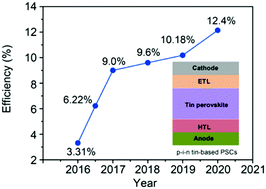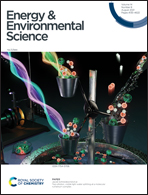Recent advances and challenges of inverted lead-free tin-based perovskite solar cells
Abstract
Lead-based perovskite solar cells (PSCs) have attracted considerable interest since 2009 owing to their excellent optical and electrical properties, achieving a certified efficiency of 25.5% over a 12 year period. However, the presence of lead in perovskites, which is a cumulative toxicant to human bodies, hampers the market prospect of these solar cells. Sn perovskites with narrow band gaps and high carrier mobilities are thus by far the most promising alternatives. Sn-Based PSCs have attracted increasing attention owing to their inverted planar p–i–n structure, which represented an important breakthrough in the field. Their main advantages include low-temperature fabrication, cost-effectiveness, and suppressed hysteresis behavior, along with a competitive power conversion efficiency of up to 12.4%. Recent progress in the device performance of p–i–n Sn-based PSCs demonstrates the promising potential of these materials. Here, recent developments and future perspectives regarding inverted p–i–n Sn-based PSCs are reviewed. In particular, this review focuses mainly on device features and charge transport layers of p–i–n Sn-based PSCs, properties of Sn perovskites, and fabrication of a high quality Sn perovskite active layer, highlighting the obstacles to further progress and opportunities for future work. The current challenges and prospects for Sn-based PSCs are also discussed.

- This article is part of the themed collection: Energy and Environmental Science Recent Review Articles


 Please wait while we load your content...
Please wait while we load your content...